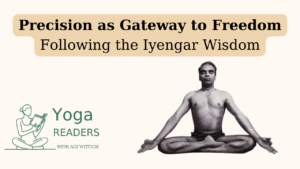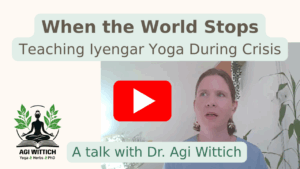
The Body as Laboratory: Cultivating Awareness through Practice
“To a yogi, the body is a laboratory for life, a field of experimentation and perpetual research.”—B.K.S. Iyengar This insight from Guruji is not

From its intriguing name to its profound effects, Yoga Kurunta offers a fascinating approach to yoga practice that makes challenging postures accessible while deepening our understanding of alignment and movement. As Geeta Iyengar beautifully explains in “Yoga: A Gem for Women,” “Kurunta is a puppet, a doll made of wood… Here the puppeteer and the puppet are one, performing their own puppet-show.” This metaphor perfectly captures the unique relationship between practitioner and prop in this transformative practice.
The Philosophy Behind Kurunta Practice
The term “Kurunta” derives from Sanskrit, meaning “puppet,” highlighting the unique nature of this practice where practitioners use ropes to guide and support their bodies through various āsanas. While often associated with B.K.S. Iyengar’s innovative approach to yoga, the practice has evolved to become an invaluable tool for practitioners of all levels.
Geeta Iyengar emphasizes the accessibility of this practice: “Performing Yogāsanas with the aid of a rope has many advantages. Difficult āsanas can be practised with ease.” She further explains that “The method is ideal for women who are heavy in the region of the thighs, the buttocks, the stomach, and for those who have become flabby after one or two deliveries.”
To dive deeper into the role of innovation and props in Iyengar Yoga, you might enjoy my free lecture on the legacy of B.K.S. Iyengar.
👉 Interested in how classical Indian philosophy informs modern yoga practice? watch my recorded lecture on Sāṃkhya Philosophy and Yoga Practice — and discover how the mind-body framework behind Yoga Kurunta is rooted in ancient thought. This is a structured introduction for yoga teachers and serious practitioners.
Understanding the Setup and Safety
The proper setup for Yoga Kurunta requires careful attention to detail. According to Geeta Iyengar’s instructions, practitioners need “a rope 1 inch thick, strong, and convenient to hold, and 16 to 18 feet long.” The rope should be mounted on secure points about 2-2½ feet apart, with the mounting height allowing practitioners to just reach the ropes when standing on tiptoes.
Safety is paramount in Kurunta practice. As Geeta Iyengar notes, “Make sure the window bars are strong enough to support the weight of your body when you pull the ropes in various positions.” This attention to proper setup ensures that practitioners can explore the practice with confidence.
The Transformative Effects
One of the most remarkable aspects of Yoga Kurunta is its therapeutic value. Geeta Iyengar explains that “Due to the rope movement the spine becomes supple and even difficult āsanas can be done easily and safely. No jerking is felt, and a sense of direction is developed by regular practice.” This gentle yet effective approach makes it particularly valuable for those with conditions such as slipped discs, back pain, shoulder issues, and general stiffness.
The benefits extend beyond the physical realm. According to Geeta Iyengar, “By the practice of Yoga Kurunta one gains agility, lightness of the body, speed in movements, and alertness in the brain.” This holistic transformation affects both body and mind, making it a powerful tool for overall well-being.
Accessibility and Adaptation
Accessibility is a cornerstone of Yoga Kurunta. As Geeta Iyengar points out, “Old people can do Yoga Kurunta without injuring themselves.” The rope support allows practitioners to build confidence gradually, experience poses more fully, and understand proper alignment while working at their own pace.
The practice is particularly beneficial for women, as Geeta Iyengar notes that the variations “are especially helpful to women as they ease the tensions in the pelvic area and stretch the pelvic organs more effectively than when done independently.”
Practical Applications
Kurunta practice can support various āsanas, from backbends like Bhujaṅgāsana (Cobra Pose) and Uṣṭrāsana (Camel Pose) to inversions like Sālamba Sarvāṅgāsana (Supported Shoulderstand) and Halāsana (Plow Pose). The rope provides support and guidance, allowing practitioners to experience the essence of each pose without strain or fear.
For backbending practices, the rope support helps practitioners achieve the concave movement of the spine while maintaining safety. In inversions, the ropes assist in lifting the body, reducing strain on the neck and shoulders while providing the therapeutic benefits of these powerful poses.
A Bridge Between Traditional and Modern Practice
In our contemporary world, where many struggle with physical limitations, stress, and the need for supported practice, Yoga Kurunta offers a bridge between traditional yoga and modern needs. It embodies the innovative spirit of the Iyengar tradition while maintaining deep roots in classical yoga philosophy. The practice demonstrates how intelligent use of props can enhance rather than diminish the yoga experience.
Through regular practice of Yoga Kurunta, practitioners can experience profound transformations in their physical and mental well-being. The practice brings lightness to the body, clarity to the mind, and a deeper understanding of yogic principles. However, as with all yoga practices, it’s essential to learn from a qualified instructor who can guide proper setup and technique, ensuring practitioners receive the full benefits of this remarkable practice while maintaining safety and alignment.
Before diving into these questions, why not support this kind of in-depth yoga writing and teaching? Buy me a chai ☕ and help sustain this work.
Reflective Questions
As you consider incorporating Yoga Kurunta into your practice, reflect on these questions:
The beauty of Yoga Kurunta lies in its ability to make advanced postures accessible while helping practitioners develop greater body awareness and control. It reminds us that sometimes, support and guidance – in the form of ropes and props – can help us achieve what might otherwise seem impossible, leading us toward a deeper and more fulfilling yoga practice.

“To a yogi, the body is a laboratory for life, a field of experimentation and perpetual research.”—B.K.S. Iyengar This insight from Guruji is not

“Asana is perfect firmness of body, steadiness of intelligence, and benevolence of spirit.”—B.K.S. Iyengar This definition invites us to rethink what it means to

I recently had the oppo rtunity to share my experience of teaching yoga during wartime, and the response has been overwhelming. People from around
Agi Wittich is a yoga practitioner since two decades, and is a certified Iyengar Yoga teacher. Wittich studied Sanskrit and Tamil at the Hebrew University of Jerusalem, Israel, completing a PhD with a focus on Hinduism, Yoga, and Gender. She has published academic papers exploring topics such as Iyengar yoga and women, the effects of Western media on the image of yoga, and an analysis of the Thirumanthiram yoga text.